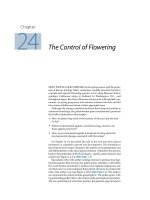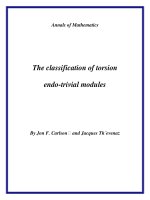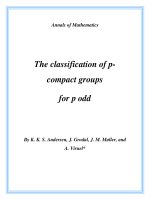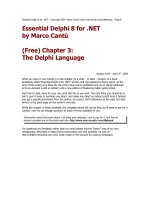Chapter 3 the classification of clastic sedimentary rocks
Bạn đang xem bản rút gọn của tài liệu. Xem và tải ngay bản đầy đủ của tài liệu tại đây (2.12 MB, 50 trang )
Chapter 3: The Classification of Clastic Sedimentary Rocks
A very basic classification of
all sedimentary rocks is
based on the type of material
that is deposited and the
modes of deposition.
Classification based on grain size
A simple classification of terrigenous clastic rocks and sediment is based
on the predominant grain size of the material:
Grain
Size1
(mm)
Sediment
name
Rock Name
Adjectives
>2
Gravel
Rudite
Cobble, pebble, well
sorted, etc.
0.0625-2
Sand
Arenite
Coarse, medium, well
sorted, etc.
< 0.0625
Mud
Mudstone
or
Lutite
Silt or clay
For the purposes of this general classification we will assign the rock or sediment
name shown if more than 50% of the particles are in the range shown. More
detailed classification schemes will limit terms on the basis of different proportions
of sediment within a given grain size.
1
Classification of Sandstones
Most sandstone classifications are based on the composition of the rock.
Dott’s classificaton scheme is used in most courses at Brock.
It is based on the relative proportions of:
Martrix (fine-grained - <0.03mm - material that is associated with the sand grains).
Quartz
Feldspar
Rock fragments (sand grains that are made up crystals of two or more different minerals).
To classify sandstones using Dott’s scheme the first step is to determine
composition of the rock.
Point counting is a method whereby a thin section on a petrographic
microscope is examined by stepping across the thin section at equal
intervals and identifying the material (quartz, feldspars, rock fragments
or matrix) that lies immediately beneath the cross hairs. Counting 250 to
300 grains will accurately yield the proportion of each component.
Example Point Count Data:
Component
Number of
Proportion
Grains counted
(%)
Quartz
73
26
Feldspar
56
20
Rock fragments
34
12
Matrix
118
42
Total:
281
100
A first order classification is
based on the proportion of
matrix that is present:
% matrix
Rock Name
< 15
Arenite
15 - 75
Wacke or
Graywacke
Mudstone
>75
Example Point Count Data:
Component
Number of
Proportion
Grains counted
(%)
Quartz
73
26
Feldspar
56
20
Rock fragments
34
12
Matrix
118
42
Total:
281
100
A first order classification is
based on the proportion of
matrix that is present:
% matrix
Rock Name
< 15
Arenite
15 - 75
Wacke or
Graywacke
Mudstone
>75
To classify Arenites and Graywacke’s on the basis of their specific
compositions the data must be “normalized” to 100% quartz, feldspars
and rock fragments.
A. Total Rock
Component
Quartz
A. Quartz, feldspars and rock fragments.
Proportion
(%)
26
Component
Quartz
Proportion1
(%)
45
Feldspar
20
Feldspar
34
Rock fragments
12
Rock fragments
21
Matrix
42 ∴ a graywacke
Total:
Total:
100
100
Total Q, F, and Rf: 58
Calculated as the proportion of each
component in the total rock divided by the
total proportion of quartz, feldspars and
rock fragments (in this case that total is
1
The next step is to plot the
normalized data on a ternary
diagram to determine the specific
field in which the data fall.
The next step is to plot the
normalized data on a ternary
diagram to determine the specific
field in which the data fall.
If the proportion of matrix is less
than 15% plot the data and use
Dott’s diagram for the
classification of arenites.
If the proportion of matrix is less
than 15% plot the data and use
Dott’s diagram for the
classification of arenites.
If the proportion of matrix is less
than 15% plot the data and use
Dott’s diagram for the
classification of arenites.
If the proportion of matrix is less
than 15% plot the data and use
Dott’s diagram for the
classification of arenites.
This classification is based on the major component of most sandstones
and provides a basis for a consistent nomenclature for sandstones.
The names can be modified to reflect other components of the rock:
e.g., Calcareous quartz arenite: a quartz arenite with a calcite cement.
Specific types of rock fragments may also be important in determining
the history of the sediment.
Fragments of limestone or dolomite are simply classed as “rock
fragments” using Dott’s scheme.
Such grains break down rapidly with transport so that their presence
suggests that the sediment was deposited very close to the area that it
was produced.
I. Genetic Implications of Sandstone Composition
In addition to providing a basis for sandstone nomenclature, the
composition of a sandstone also indicates something of its history.
a) Maturity of a sandstone
Maturity refers to the cumulative changes that particles go through as it
is produced by weathering and is transported to a final site of
deposition.
Given that the source rocks for many sediments are pre-existing
sedimentary rocks, a very mature sediment may have been through the
rock cycle several times.
Clastic sedimentary rocks
can be made up of
“multicycled” particles.
i.e., have passed through the
rock cycle several times.
Each time through the cycle
the sediment becomes more
and more mature.
Sediment texture and mineralogical composition all reflect the maturity
of a sediment.
Most changes are related to transport distance, nature of weathering at
the site of sediment formation and number of passes through the rock
cycle.
i) Textural Maturity
Changes in grain size and shape.
Increasing textural maturity
Increased sorting
Increased rounding
Increased sphericity
From: Gomez, Rosser, Peacock, Hicks
and Palmer, 2001, Downstream fining i
a rapidly aggrading gravel bed river.
Water Resources Research, v. 37, p.
1813-1823.
Demir, 2003, Downstream changes in
bed material size and shape
characteristics in a small upland stream
Cwm Treweryn, in South Wales,
Yerbilimleri, v. 28, p. 33-47.
The name of a sandstone tells you something of its maturity.
E.g., a Quartz arenite has less than 15% matrix and is better sorted than
a Quartz graywacke.
The quartz arenite is more mature (greater transport distance and/or
more times through the rock cycle) than the Quartz graywacke.
ii) Compositional Maturity
Compositional maturity is reflected by the relative proportion of
physically soft or chemically unstable grains.
The fewer the soft or unstable grains, the more mature the sediment.
What is the relative stability of minerals?
Bowen’s Reaction series shows the sequence in which minerals
crystallize from a cooling magma.
Mineral stability can also be shown using Bowen’s Reaction series:
The earliest minerals to crystallize are the least stable.
Quartz is the most stable of the common mineral; it resists chemcial
weathering and is the most common mineral in most sedimentary rocks.
Potassium feldspar is
also common but
Muscovite is relatively
soft and breaks down
during transport.
The stability of rock
fragments varies with
their mineralogy.
The most “mature” sediment would be made up of 100% quartz
grains.
With increased transport and number of times through the rock cycle
the less stable minerals are lost.
The “average” igneous and metamorphic rocks contain 60%
feldspars.
The “average” sandstone contains 12% feldspars.
This reflects the fact that many sandstones are made up of particles
that have been through several passes of the rock cycle.
b) Provenance of a sediment
Provenance: where something originated.
The Provenance of a sediment is inferred from aspects of composition
that reflect the source rock and tectonic and climatic characteristics of
the source area for the sediment.
i) Tectonic setting
The source rock of a sediment and the tectonic setting are closely linked:
the tectonic setting determines the relative abundance of different types
of rock that is available for weathering and the production of clastic
sediment.
e.g., An arkosic sandstone (rich in feldspars) would have a source area
that is rich in granites.
A mountain chain adjacent to a convergent margin (e.g., modern Andes)?
An exposed craton (e.g., the Canadian Shield)?









